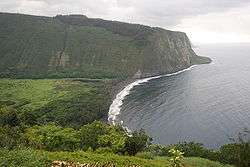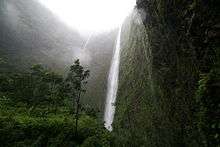Waipio Valley
Waipiʻo Valley is a valley located in the Hamakua District of the Big Island of Hawaiʻi. "Waipiʻo" means "curved water" in the Hawaiian language.[1]


It was the capital and permanent residence of many early Hawaiian Aliʻi (chiefs/kings) up until the time of King ʻUmi. This was a place celebrated for its nioi tree (Eugenia reinwardtiana) known as the Nioi wela o Paʻakalana ("The burning Nioi of Paʻakalana"). It was the location of the ancient grass palace of the ancient "kings" of Hawaiʻi with the nioi stands. Kahekili II (king of Maui) raided Waipiʻo in the 18th century and burned the four sacred trees to the ground. The first chief who had a court in this valley was called Kahaimoelea.
The valley floor at sea level is almost 2,000 ft (610 m) below the surrounding terrain. A steep road leads down into the valley from a lookout point located on the top of the southern wall of the valley. The road rises 800 feet (240 m) in 0.6 miles (1.0 km) at a 25% average grade, with steeper grades in sections. This is a paved public road but it is open only to 4 wheel drive vehicles. It is the steepest road of its length in the United States.[2] The shore line in the valley is a black sand beach, popular with surfers. A few taro farms are located in the valley.[3] Several large waterfalls fall into the valley to feed the river which flows from the foot of the largest falls at the back of the valley out to the ocean.[4]
A foot trail called Waimanu or Muliwai Trail leads down a steep path to the Waimanu Valley, which is not accessible by automobile. The trail is accessible by hikers.[5] At the upper end of the valley, Waimanu Gap at 2,089 feet (637 m) elevation leads to the south end of Waimanu Valley.[6]
The valley was the site of the final scene in the 1995 sci-fi film Waterworld, at which the main characters found dry land.[7]
In Hawaiian folklore
It has a role in local Hawaiian folklore as a place where the gateway to Lua-o-Milu (the Underworld) was hidden from view by sand.[8]
References
- lookup of Waipiʻo on Hawaiian place names web site
- Summerson, J: "The Complete Guide to Climbing (by Bike)", page 165. Extreme Press, 2007
- Hitt, Christine (April 21, 2019). "Learning Hawaii's history may be key to avoiding cultural insensitivity". Los Angeles Times. Retrieved 2019-04-22.
- History of the Waipiʻo Valley
- "Waipiʻo Valley Beach Hiking Trail | Hawaii Big Island Hikes". Go Hike It. 2017-07-01. Retrieved 2017-08-08.
- Lloyd J. Soehren (2004). "lookup of Waimanu Gap". on Hawaiian place names. Ulukau, the Hawaiian Electronic Library. Retrieved 2010-04-13.
- Locations | Waterworld (1995) on IMDB
- Thrum, Thomas (1907). Hawaiian Folk Tales. A. C. McClurg. p. 12.
External links
| Wikimedia Commons has media related to: |